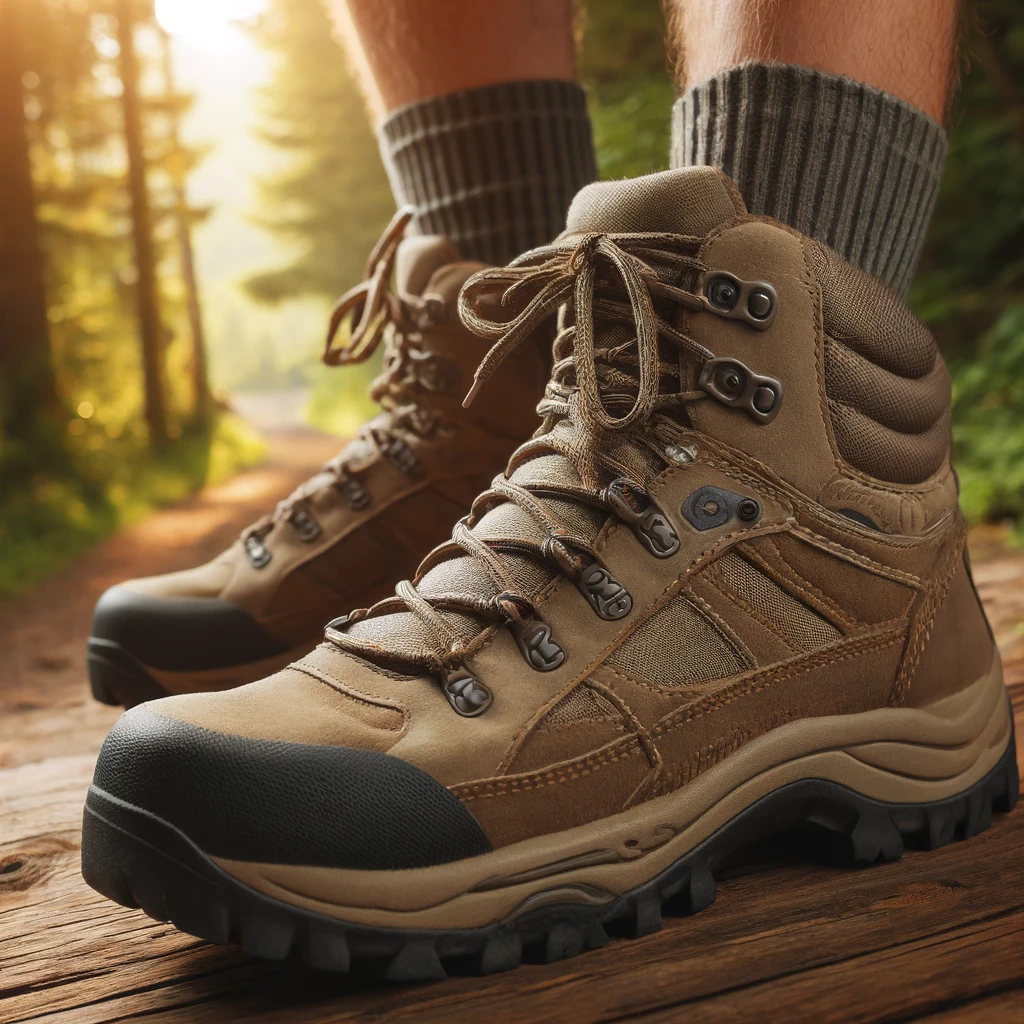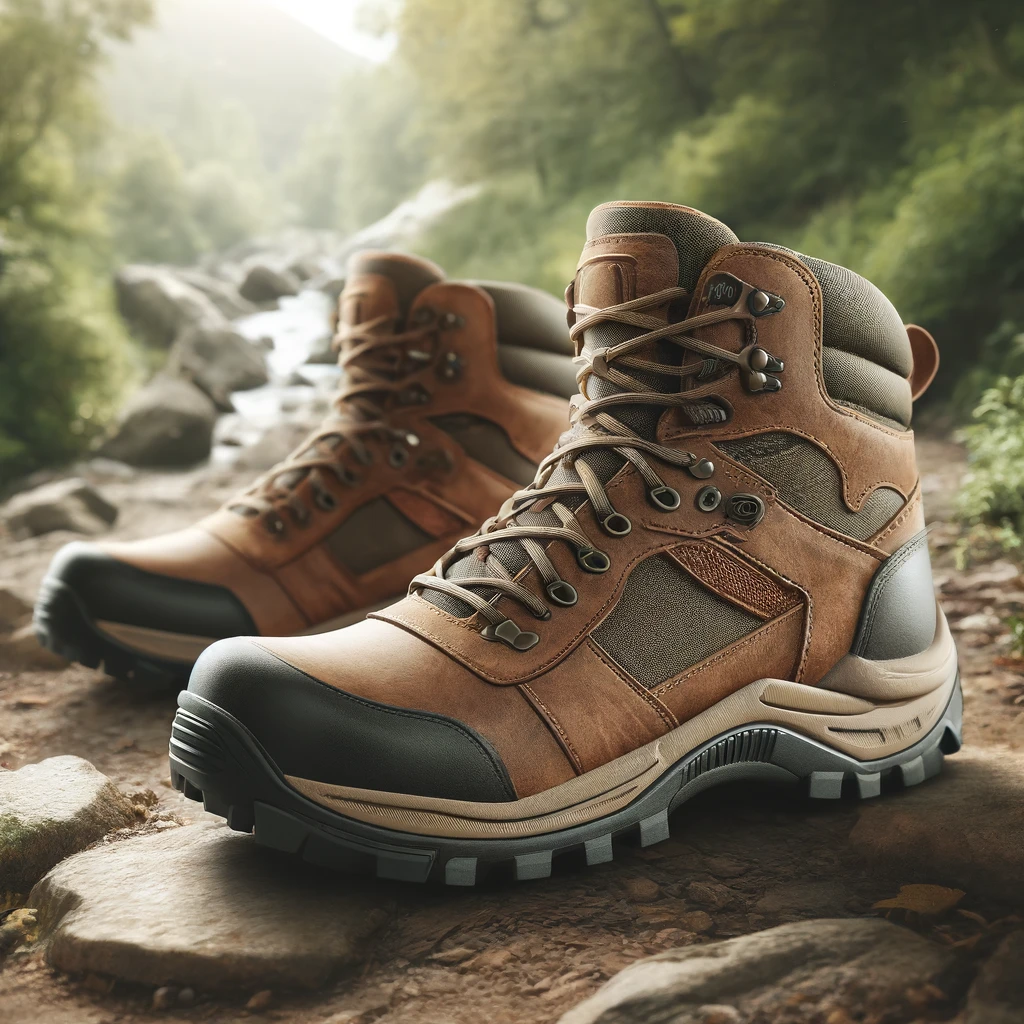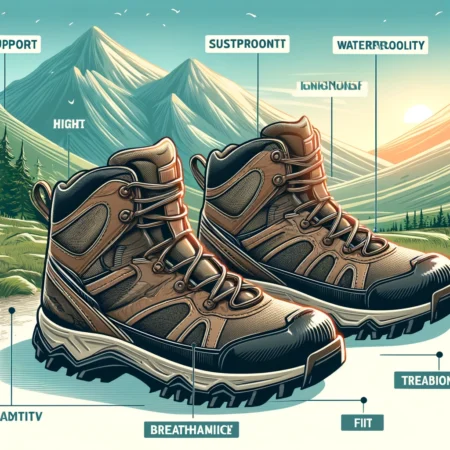Choosing the right hiking boots is a critical step for anyone new to hiking. The right pair of boots can make the difference between an enjoyable hike and a painful experience. Here’s a comprehensive guide to help beginners select the best hiking boots.

Understanding Your Hiking Needs
Before diving into the different types of hiking boots available, it’s essential to understand your specific hiking needs. Consider the following factors:
- Terrain: Are you hiking on well-maintained trails, rocky paths, or uneven terrain? The rougher the terrain, the more support you will need from your boots.
- Weather Conditions: Will you be hiking in dry, wet, snowy, or muddy conditions? Waterproof boots are essential for wet conditions, while breathable boots are better for dry and hot climates.
- Hiking Duration: Are you planning short day hikes or multi-day backpacking trips? Longer hikes require more durable and supportive boots.

Types of Hiking Boots
1. Hiking Shoes
- Best For: Day hikes on well-maintained trails.
- Features: Low-cut models with flexible midsoles. They are lightweight and provide good comfort and breathability.
- Pros: Easy to break in, lightweight, and breathable.
- Cons: Less ankle support and protection.
2. Day Hiking Boots
- Best For: Day hikes and short backpacking trips with light loads.
- Features: Mid- to high-cut models that provide more support than hiking shoes.
- Pros: Require little break-in time, offer better ankle support.
- Cons: Not as durable as backpacking boots, less support for heavy loads.
3. Backpacking Boots
- Best For: Multiday trips with heavy loads on rugged terrain.
- Features: High-cut boots that provide excellent ankle support and durability.
- Pros: Superior support and protection, durable.
- Cons: Heavier and require more break-in time.
Key Features to Look For
1. Material
- Full-Grain Leather: Offers excellent durability, water resistance, and abrasion resistance. Best for long trips, heavy loads, and rugged terrain.
- Split-Grain Leather: Paired with nylon or nylon mesh to provide good breathability. Less water-resistant and durable than full-grain leather but lighter and more affordable.
- Nubuck Leather: Similar to suede, it is durable, flexible, and resistant to water and abrasion.
- Synthetics: Materials like polyester, nylon, and synthetic leather are lighter, dry faster, and break in more quickly than leather. However, they may not be as durable.
2. Waterproofing
- Waterproof Membranes: Boots with membranes like Gore-Tex keep feet dry in wet conditions but may reduce breathability.
- Non-Waterproof Boots: More breathable and quicker to dry but not suitable for wet conditions.
3. Midsole
The midsole provides cushioning and determines the stiffness of the boot. Common materials include:
- EVA (Ethylene Vinyl Acetate): Lightweight and cushier, often found in day hiking boots.
- Polyurethane: Firmer and more durable, typically used in backpacking boots.
4. Outsole
- Lug Pattern: Deep, thick lugs provide better traction and are essential for rugged terrain.
- Heel Brake: A distinct heel zone that helps prevent slipping on steep descents.
Fitting Your Hiking Boots
A perfect fit is crucial for preventing blisters and ensuring comfort. Here’s how to ensure a good fit:
- Measure Your Feet: Have your feet measured to determine your exact size. Remember that foot size can change over time.
- Try Boots On Later in the Day: Feet swell throughout the day, so it’s best to try boots on in the afternoon or evening.
- Wear Hiking Socks: Use the socks you plan to wear while hiking when trying on boots.
- Check for Fit Issues: Ensure there are no odd bumps, seams, or pinching. Your toes should not hit the end of the boot, and there should be room to wiggle your toes.
- Test Them Out: Walk around in the boots, climb stairs, and find an inclined surface to test them.

Breaking In Your Hiking Boots
Before embarking on a long hike, it’s crucial to break in your new boots to avoid discomfort and blisters:
- Wear Them Around the House: Start by wearing your boots around the house or for short walks.
- Gradually Increase Distance: Take longer walks and gradually increase the distance.
- Pay Attention to Hot Spots: Address any areas where you feel discomfort or hot spots. Consider using different lacing techniques to improve the fit.
Conclusion
Choosing the right hiking boots for beginners involves understanding your specific hiking needs, selecting the appropriate type of boot, considering key features, ensuring a proper fit, and breaking them in gradually. With the right pair of hiking boots, you’ll be well-prepared for a comfortable and enjoyable hiking experience.
Frequently Asked Questions
How do I choose the right hiking boots for my needs?
When selecting hiking boots, consider the terrain you’ll be hiking on, the climate, and the duration of your hikes. Look for a balance of support and flexibility, ensure they are waterproof if you hike in wet conditions, and check the breathability for comfort.
What should I look for in terms of support and flexibility in hiking boots?
Choose boots that offer ankle support for rough terrain but also have some flexibility to allow natural foot movement. A well-balanced boot can prevent injuries and provide comfort on various types of trails.
Why is waterproofing important in hiking boots?
Waterproofing is crucial if you’ll be hiking in wet conditions or crossing streams. It keeps your feet dry, preventing blisters and discomfort. Look for boots with a waterproof membrane like Gore-Tex.
How does breathability impact the comfort of hiking boots?
Breathability allows air to circulate, keeping your feet cool and reducing sweat. This helps prevent blisters and keeps your feet comfortable during long hikes. Materials like mesh panels can enhance breathability.
What type of traction should I look for in hiking boots?
Opt for boots with sturdy soles and a good lug pattern. Deep lugs provide better grip on various surfaces, from muddy trails to rocky paths, reducing the risk of slipping.
How do I ensure a proper fit for my hiking boots?
Get your feet measured professionally, try on boots at the end of the day when your feet are slightly swollen, and wear the socks you plan to hike in. Walk around the store to test comfort and fit.
Should I choose light or heavy hiking boots?
It depends on your hiking conditions. Light boots are great for short hikes and well-maintained trails, offering flexibility and requiring less break-in time. Heavy boots provide more support and durability for rough terrains and long hikes.
How do I break in new hiking boots?
Wear your new boots around the house and for short walks to gradually soften the material. This helps the boots mold to your feet, reducing the chances of blisters and discomfort on the trail.
Can I wear trail runners instead of hiking boots?
Yes, trail runners are a good option for light hiking on well-maintained trails. They are lighter and more flexible but offer less ankle support than traditional hiking boots.
Is it necessary to size up in hiking boots?
You may need to size up by half a size to accommodate foot swelling during long hikes. Ensure there’s enough room to wiggle your toes without the boots feeling too loose, which can cause blisters.









